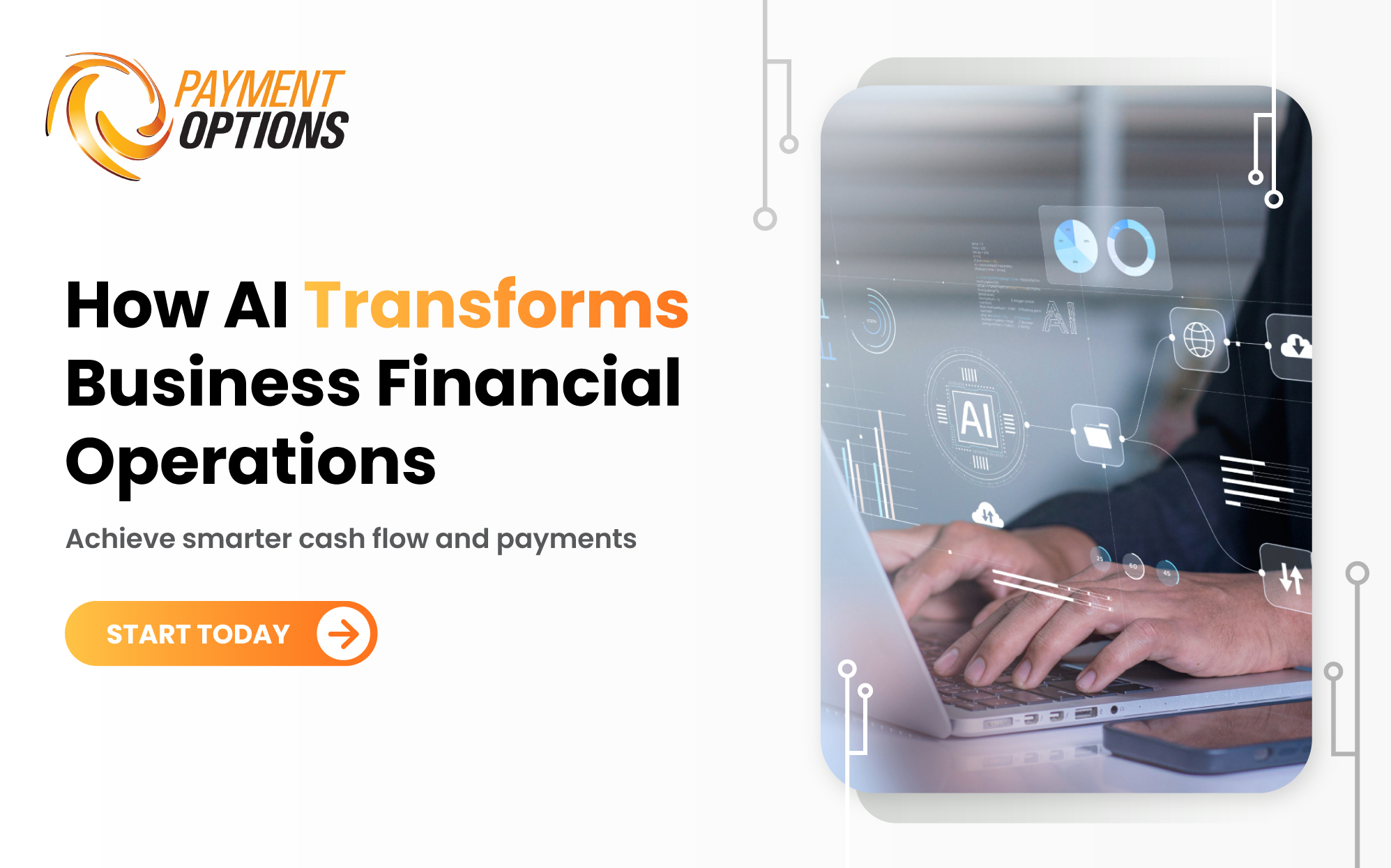How AI Transforms Business Financial Operations

For small and medium-sized enterprises (SMEs), Artificial Intelligence (AI) is becoming a powerful tool to transform how businesses manage their finances, streamline payments, and build lasting customer relationships.
This shift allows SMEs to move away from reactive decision-making and towards proactive, insight-driven strategies. The result is not just greater efficiency, but also stronger resilience and competitiveness in a fast-changing business environment.
Cash flow is often the single biggest pressure point for SMEs. Many still depend on spreadsheets or delayed reports, which makes it hard to anticipate problems before they happen.
AI transforms cash flow management by offering real-time predictions based on historical transactions, seasonal sales cycles, and customer behaviour. Instead of reacting to shortages, business owners can spot risks in advance and take corrective action.
What this means for your business:
Late payments and manual reconciliation are pain points that drain both time and energy. For many SMEs, these inefficiencies create unnecessary cash flow stress and administrative overhead.
AI reshapes payment processes by making them faster, smarter, and more reliable. Automated invoicing and intelligent reminders reduce late payments, while machine learning algorithms detect unusual transactions to prevent fraud. When combined with digital payment solutions such as online gateways, QR codes, or subscriptions, AI can also automate reconciliation, ensuring that accounts match up in real time.
What this means for your business:
At the heart of every business are the customers. Customers expect personalized experiences, even in how they pay or interact with a business.
AI enables SMEs to deliver that personalization at scale. By analysing customer spending patterns, AI can suggest tailored payment methods, loyalty rewards, or promotions that feel relevant to each individual. Simple touches, like offering instalment plans or sending personalized reminders, show customers that their needs are understood.
What this means for your business:
Decision-making in SMEs often relies on gut feel or incomplete data. While intuition has its place, it can expose businesses to risk, especially when markets shift quickly.
AI gives SMEs the ability to make decisions backed by real-time data and predictive analytics. For example, AI-powered dashboards can provide instant visibility into financial health, while machine learning models can score customer creditworthiness or forecast sales demand with greater accuracy. This allows SMEs to plan strategically, avoid unnecessary risks, and spot opportunities earlier than competitors.
What this means for your business:
AI is powerful, but adoption doesn’t come without hurdles. SMEs face unique challenges such as limited budgets, skills gaps, and concerns about trust. However, these barriers can be managed with the right approach.
Steps to take: Start small with affordable, subscription-based AI tools. Prove ROI in one area, then scale gradually.
Steps to take: Choose low-code or no-code platforms and invest in staff training through short courses or workshops.
Steps to take: Use platforms that clean and standardize data automatically, and ensure new tools integrate with existing workflows.
AI is not here to replace SMEs, it’s here to transform how they operate. From cash flow management and payments to customer engagement and smarter decision-making, AI empowers businesses to be proactive, efficient, and resilient.
With the right mindset and approach, SMEs can harness AI to gain a competitive edge. When used wisely, AI doesn’t just optimize business—it elevates it.
This shift allows SMEs to move away from reactive decision-making and towards proactive, insight-driven strategies. The result is not just greater efficiency, but also stronger resilience and competitiveness in a fast-changing business environment.
1. Revolutionizing Cash Flow & Working Capital
Cash flow is often the single biggest pressure point for SMEs. Many still depend on spreadsheets or delayed reports, which makes it hard to anticipate problems before they happen.
AI transforms cash flow management by offering real-time predictions based on historical transactions, seasonal sales cycles, and customer behaviour. Instead of reacting to shortages, business owners can spot risks in advance and take corrective action.
What this means for your business:
- Predict cash gaps before they occur.
- Take proactive steps to maintain liquidity.
- Reinvest freed-up capital into growth initiatives.
2. Streamlining Payments and Collections
Late payments and manual reconciliation are pain points that drain both time and energy. For many SMEs, these inefficiencies create unnecessary cash flow stress and administrative overhead.
AI reshapes payment processes by making them faster, smarter, and more reliable. Automated invoicing and intelligent reminders reduce late payments, while machine learning algorithms detect unusual transactions to prevent fraud. When combined with digital payment solutions such as online gateways, QR codes, or subscriptions, AI can also automate reconciliation, ensuring that accounts match up in real time.
What this means for your business:
- Get paid faster with automated invoicing and reminders.
- Reduce errors and fraud through intelligent monitoring.
- Save time with AI-assisted reconciliation.
3. Strengthening Customer Relationships
At the heart of every business are the customers. Customers expect personalized experiences, even in how they pay or interact with a business.
AI enables SMEs to deliver that personalization at scale. By analysing customer spending patterns, AI can suggest tailored payment methods, loyalty rewards, or promotions that feel relevant to each individual. Simple touches, like offering instalment plans or sending personalized reminders, show customers that their needs are understood.
What this means for your business:
- Offer payment options tailored to customer needs.
- Build loyalty with personalized rewards and promotions.
- Strengthen trust with faster, more responsive support.
4. Smarter Financial Decision-Making
Decision-making in SMEs often relies on gut feel or incomplete data. While intuition has its place, it can expose businesses to risk, especially when markets shift quickly.
AI gives SMEs the ability to make decisions backed by real-time data and predictive analytics. For example, AI-powered dashboards can provide instant visibility into financial health, while machine learning models can score customer creditworthiness or forecast sales demand with greater accuracy. This allows SMEs to plan strategically, avoid unnecessary risks, and spot opportunities earlier than competitors.
What this means for your business:
- Use real-time dashboards to stay on top of financial health.
- Assess risks more accurately with AI-driven models.
- Plan ahead using predictive sales and demand insights.
Challenges of AI Adoption
AI is powerful, but adoption doesn’t come without hurdles. SMEs face unique challenges such as limited budgets, skills gaps, and concerns about trust. However, these barriers can be managed with the right approach.
High Costs and Uncertain ROI
AI tools can seem expensive, especially for smaller businesses. The risk of unclear returns often discourages adoption.Steps to take: Start small with affordable, subscription-based AI tools. Prove ROI in one area, then scale gradually.
Skills Gap and Training Needs
Many SMEs don’t have in-house expertise to manage or interpret AI tools effectively.Steps to take: Choose low-code or no-code platforms and invest in staff training through short courses or workshops.
Data Quality and Integration Issues
AI is only as good as the data it uses, and many SMEs struggle with fragmented or messy systems.Steps to take: Use platforms that clean and standardize data automatically, and ensure new tools integrate with existing workflows.
Conclusion
AI is not here to replace SMEs, it’s here to transform how they operate. From cash flow management and payments to customer engagement and smarter decision-making, AI empowers businesses to be proactive, efficient, and resilient.
With the right mindset and approach, SMEs can harness AI to gain a competitive edge. When used wisely, AI doesn’t just optimize business—it elevates it.





